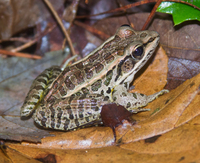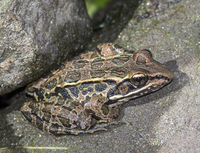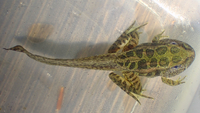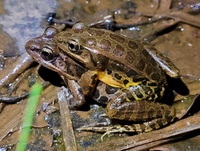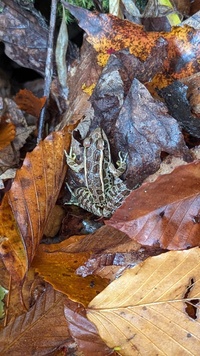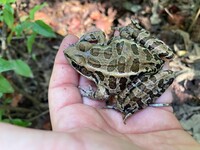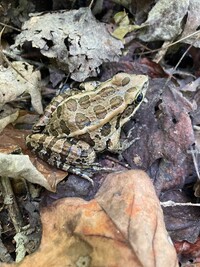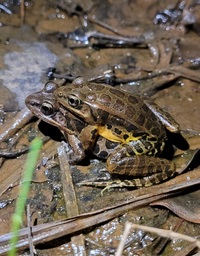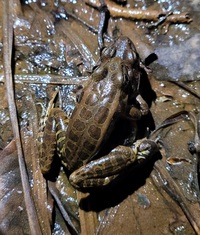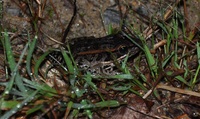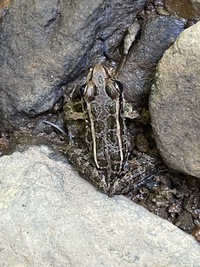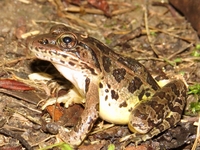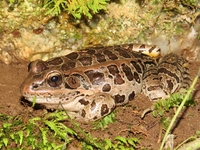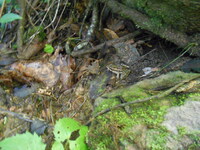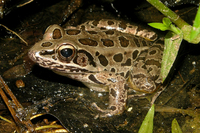Taxonomy
Class: AmphibiaOrder: AnuraFamily: RanidaeSynonym: Rana palustris
Taxonomic Comments: Frost et al. (2006) placed species in North American that were formerly in the very large genus Rana into a separate genus, Lithobates , to distinguish them from a large and predominantly Eurasian genus Rana (sensu stricto). There have been numerous arguments put forth for well over a decade about whether these species should be placed back into Rana or retained as Lithobates , with some supporting placing Lithobates as a subgroup within Rana and others supporting the recognition of both genera. There has been no clear resolution of the issue, and both Lithobates and Rana continue to be widely used in recent published literature on North American species. Here, we follow the recommendations of the Society for the Study of Amphibians and Reptiles' Standard English Names Committee and use Lithobates for North American representatives of this group. Species Comments:
Identification
Description: Adult Lithobates palustris are medium to large frogs with a pointed snout and an olive green to brownish ground color. A conspicuous light to cream-colored dorsolateral fold extends down each side of the body from behind the eye to the groin region. A series of large dark brown blotches (typically 10-16) are present between the dorsolateral folds that are arranged in two rows. The blotches are often narrowly margined with cream-coloration and can assume various irregular shapes. These range from highly elongate to roughly elliptic, oval, rectangular or squarish. A third row of large blotches is present on the side of the body immediately below the dorsolateral fold, along with a series of progressively smaller blotches towards the juncture with the belly. The skin on the dorsum is mostly smooth, but there are often two or more raised ridges of variable lengths between the dorsolateral folds that tend to be centered on the dorsal spots. The dorsum of the rear limbs usually have a series of dark bands, but these are sometimes replaced by blotches. The undersides are typically white except for a conspicuous yellowish to orange wash in the groin region and on the underside of the hind limbs. A whitish to cream-colored line is present on each side that extends from near the nares rearward along the upper jaw before ending below and just beyond the tympanum. L. clamitans and L. catesbeianus . L. palustris mansuetii ) but it is no longer recognized by taxonomists since morphs of this type have been found in other areas of the range. Vocalizations: The males produce several types of vocalizations, including an advertisement call and two additional calls associated with aggressive interactions with other males (Given 2005). The advertisement call has been likened to a continuous low-pitched snore. Each call lasts for 1-2 seconds and tends to be most intense near the middle of the call. Individuals normally pause for 5-10 seconds before issuing another call. Given (2005) found that the duration of the call tends to increase with body size, which may allow females to discrimination between individuals based on male size. Technical Reference: Dodd (2013)Online Photos: Google iNaturalist Observation Methods: The juveniles and adults are sometimes encountered while crossing roads on rainy nights, while the calling males can be heard during the spring warm-up and early summer. Individuals are occasionally flushed when walking along the margins of woodland streams.
Download Video:
"MP4"
AmphibiaWeb Account
Distribution in North Carolina
Distribution Comments: The Pickerel Frog is broadly distributed throughout eastern North America from southeastern Canada south and southwestward to eastern Texas and a small portion of the Gulf Coast. This species is unevenly distributed in the eastern US, with populations apparently missing from regional areas such as much of Illinois and portions of western Tennessee. The western limit of the range generally corresponds to the Eastern Deciduous Forest and ends in eastern Texas, eastern Oklahoma, and comparable areas farther north to Wisconsin and northern Michigan. In North Carolina, populations tend to be patchily distributed in some areas of the state. They are most common in the Piedmont, and rather poorly represented in the southwestern mountains and the Coastal Plain where suitable habitats are less common (Beane et al. 2010). Distribution Reference: Beane et al. (2010), Dodd (2013)County Map: Clicking on a county returns the records for the species in that county.
GBIF Global Distribution
Key Habitat Requirements
Habitat: The Pickerel Frog is generally associated with forested landscapes with appropriate breeding sites, but can also be found in areas with a mosaic of forested and non-forested patches such as meadows or agricultural fields. The juveniles and adults tend to seek out cool microhabitats after moving from the breeding sites and can be found in mesic and bottomland forests, moist meadows and marshes, sphagnum bogs, cool ravines, and along cold streams and rivers (Dodd 2013). Southern populations are often found in bottomland forests, swamp forests, or in steep, shaded ravines. This species is regularly found in caves or near cave entrances in karst regions where they use these as overwinter sites and thermal refugia. Fenoilio et al. (2005), for example, observed a seasonal peak count of 53 individuals in November in a cave in the Ozarks, while Resetarits (1986) estimated a cave in Missouri to contain at least 365 overwintering individuals. Lithobates palustris normally breeds in semipermanent or permanent wetlands (e.g., Babbitt et al. 2003, Herrmann et al. 2005) and will often use large bodies of water such as ponds and larger lakes. It also uses a variety of other natural and artificial breeding habitats, including beaver ponds, marshes, isolated Coastal Plain wetlands (Russell et al. 2002a), small reservoirs, retention ponds, farm ponds, rock quarries and sand pits (Dodd 2013). Individuals breed in both fish-free habitats and permanent habitats with fish (Baber et al. 2004, Hecnar 1997, Hecnar and M’Closkey 1997b). The breeding sites often have shallow zones with emergent vegetation and a partial to complete canopy cover. In addition to standing water habitats, the adults occasionally breed in pools in spring-fed streams and other cold habitats. Wright (1914) reported them using cold streams and the plunge pools of waterfalls in New York, while Holomuzki (1995) found them in a second-order section of a Kentucky stream where fish densities were low. Environmental and Physiological Tolerances: Lithobates palustris is not highly acid-tolerant, with the critical pH for the eggs and larvae being between 4.3 and 4.5 (Dodd 2013, Gosner and Black 1957a). Biotic Relationships: The eggs and larvae can be found in both running and standing water habitats and are exposed to numerous aquatic predators. Eastern Newts (Notophthalmus viridescens ) will eat the eggs (Wright 1914) and the larvae are undoubtedly taken by numerous aquatic predators, including odonates and Eastern Newts (Wilbur and Fauth 1990). Holomuzki (1995) studied a stream-breeding population in Kentucky and found that the larvae appear to have limited chemical defenses against one sunfish (Lepomis megalotis ), but not a second (L. cyanellus ). The tadpoles reduced their activity levels when exposed to chemical cues from Lepomis megalotis , and minimized predation risk by remaining in very shallow water near the stream edge. Esox ), the Common Watersnake (Nerodia sipedon ) and mink. There is also one record of predation by a Bald Eagle (Dodd 2013). Gartersnakes (Thamnophis sirtalis ; T. sauritus ) will sometimes reject Pickerel Frogs (Babbitt 1937, Dunn 1935, Walker 1946) as will the Common Watersnake (Nerodia sipedon ) and shrews (Blarina ; Babbitt 1937, Formanowicz and Brodie 1979).
Life History and Autecology
Breeding and Courtship: Breeding in local populations can occur from winter through early summer depending on the latitude and local site conditions. Males in the southern portion of the range may begin calling as early as December-February (Dundee and Rossman 1989, Garrett and Barker 1987, Hardy and Raymond 1991, Mount 1975), while those in the northern US and Canada may not begin until late April or May (e.g., Babbitt 1937, Dodd 2013, Oliver and Bailey 1939, Wright 1914). In North Carolina, calling typically begins in mid-February or later and last for around 4-6 weeks in local populations (Murphy 1963, Todd et al. 2003). Hocking et al. (2008) found that males and females tended to arrive at the same time, which suggests that the breeding season roughly parallels the calling season. Wright (1914) noted that the egg-laying period typically last for only three weeks in New York for any given site and year. However, it varies substantially across years and sites so that the entire breeding season extends for around six weeks. Reproductive Mode: Each female lays a single globular to somewhat oblong egg mass that is commonly around 8-10 cm in diameter when fully swollen. The size of 14 egg masses from Wisconsin measured by Johnson (1984) varied from 5.0-14 cm (mean = 8.8 cm) by 5.0-13 cm (mean = 8.1 cm). Females typically attach their egg masses to submerged branches, sticks, plant stems or other support structures. The egg masses are often laid in shallow water in relatively sunny locations, but are sometimes placed in deeper water up to a meter below the surface (Johnson 1984, Wright 1914). Females that bred in a stream in Kentucky deposited their masses in deep water in pools that were relatively permanent (Holomuzki 1995). Aquatic Life History: The tadpoles appear to filter-feed on muddy substrates and consume diatoms, blue-green algae, and both filamentous and non-filamentous green algae (Dodd 2013). The larvae are capable of rapid growth and can reach 60-70 mm TL within a few months after hatching. Growth rates are presumably dependent on ambient conditions such as food levels, water temperatures, and the densities of predators and competitors, but almost no information is available from natural breeding sites. Terrestrial Life History: The ecology of the young metamorphs and juveniles is poorly documented. The metamorphs begin dispersing away from the breeding sites within a few weeks after metamorphosing (Hocking et al. 2008), but information on the distances that they move, use of dispersal corridors, and microhabitat use are lacking. Both the juveniles and adults tend to emigrate during rainy weather (Murphy 1963). Adults that were tracked in Wisconsin by Johnson (1984) were sedentary during the summer months and remained in very close vicinity to spring-fed streams where they frequented bank overhangs and root tangles.
General Ecology
Population Ecology: We know very little about local population sizes or population structure for this species. The Pickerel Frog tends to be spottily distributed in many areas of its range. It is often underrepresented in occupancy surveys and is considered uncommon or rare in many areas (Dodd 2013). Many seemingly good habitats lack breeding populations for reasons that are not fully understood. We have very little data on the dispersal distances and movements of the juveniles and adults. The extent to which local and regional populations are interconnected and show evidence of metapopulation structure needs study. Community Ecology: The tadpoles usually share breeding sites with potential competitors and predators, but interactions between these groups are poorly researched. Wilbur and Fauth (1990) examined community interactions of two predators (Eastern Newt; Anax dragonfly) with two combinations of prey (Anaxyrus americanus ; L. palustris ) in experimental tanks. Under these conditions, Pickerel Frog tadpoles suffered greater mortality from odonate larvae than newts, and competed with toad tadpoles in the absence of these predators. The predators reduced the densities of tadpoles in the tanks and mediated both intra- and interspecific growth responses that were presumably due to competition for limited food resources.
Adverse Environmental Impacts
Status in North Carolina
NHP State Rank: S5Global Rank: S5Environmental Threats: The Pickerel Frog is spottily distributed throughout much of its range, but it is uncertain whether this reflects a natural pattern or long-term anthropogenic losses (Dodd 2013). Populations appear to have declined in some areas such as Kansas where the species was last reported in 1934. This species tends to avoid open areas such as pastures or grassy road corridors when dispersing and favors forested habitats and stream corridors (Gibbs 1998a). Areas with urban development, fragmented landscapes, and high road densities provide poor habitats for local populations. Status Comments: This species appears to be relatively common in North Carolina compared to many areas of the range. There is no evidence of significant population declines in recent years. Stewardship: Populations are best maintained by having a series of local semipermanent or permanent wetlands that are interspersed in a forested matrix. Wooded stream corridors appear to be important landscape features that are used during dispersal and migration to and from breeding sites and should be protected to maintain connectivity between local pond populations.
Photo Gallery for Lithobates palustris - Pickerel Frog 21 photos are shown. Recorded by: J. Reynolds, K. Jordan Recorded by: Stephanie Willis Recorded by: Stephanie Willis Recorded by: C. Stirrat Recorded by: Andrew W. Jones Recorded by: Andrew W. Jones Recorded by: Andrew W. Jones Recorded by: Pete Dixon Recorded by: Carol Ann McCormick Recorded by: K. Bischof Recorded by: tom ward Recorded by: H. Quay Recorded by: John Petranka Recorded by: tom ward Recorded by: tom ward Recorded by: A. Lasley Recorded by: Owen McConnell Recorded by: Pat Momich Recorded by: John Petranka Recorded by: Steve Hall Recorded by: Owen McConnell

 »
»